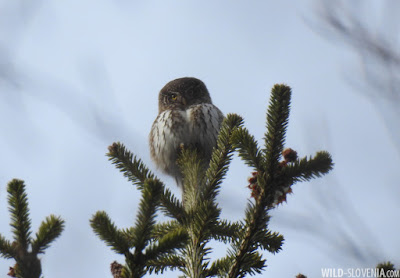
This winter has been so far particularly snowy, with weekly and abundant snowfalls in the mountains (as well as almost daily rainfalls in the lowlands) throughout December. Mount Snežnik, being known as the "snowy mountain", was no exception. This week we took the chance to combine some fieldwork with snowshoeing in the plateau's extensive forests. Along our track we measured a layer of 70-80 cm of snow, therefore snowshoes were rather useful. The snow was very fresh, maybe even too fresh to find any mammals' tracks - we only came across a few footprints of Fox Vulpes vulpes and Red Squirrel Sciurus vulgaris. As it is typical for winter, the forest was mostly silent, with only occasional small flocks of birds concentrated in specific areas. Until the early afternoon we didn't see anything unusual, only common forest birds like Coal Periparus ater & Crested Tits Lophophanes cristatus, Goldcrest Regulus regulus and a Bullfinch Pyrrhula pyrrhula. Every time we visit mountain forest in winter we wonder how on earth these tiny birds manage to survive the winter in the harsh mountain envorinment. Most of the birds however concentrate in areas with conifers (where there's more food and cover), while the leaf-less beech canopies become completely empty once snow falls.
 |
Snowshoeing in the fresh snow of mount Snežnik.
|
 |
One of the several closed forest roads. At the time of writing this chain is probably completely covered by snow.
|
 |
For about half an hour also a light snowfall greeted us on the way.
|
 |
The surroudning peaks above 1400 metres are completely snow-encrusted.
|
 |
Bullfinch Pyrrhula pyrrhula
|
 |
The epiphytic lichens known as tree lungworts Lobaria pulmonaria (excellent indicators of clean air), are a common sight on Sycamores Acer pseudoplatanus in the forests of Snežnik.
|
 |
Bird's-nest Orchid Neottia nidus-avis (last year's plant).
|
 |
Some beech trees have forgotten to shade their leaves.
|
In the afternoon, when passing by a stand of conifers on the edge of a dolina (sinkhole), a mixed flock of rather noisy tits caught our attention. Among them were also some loud
Willow Tits Poecile montanus. Nothing unusual we thought, until an excited flock of
Crossbills Loxia curvirostra joined the show and began to alarm. When Crossbills alarm in group with other birds, this often means a Pygmy Owl is around. And sure enough, after some minutes of listening and searching with bins, we realised the centre of activity was on the tree right above our heads. On the top of a silver fir
Abies alba, a small and unusually rounded shape was perched - it was a beautiful
Pygmy Owl Glaucidium passerinum. Although we were standing right under the tree, the owl wasn't bothered by our presence but rather paying attention to the small birds flitting around it and alarming. This precious moment lasted for about 5 minutes, before all the mobbing stopped and the Pygmy Owl flew off on another conifer, where we couldn't relocate it anymore (they are so small!). Although we have seen the species several other times in this area (
see here), it
still remains a quite rare bird in the Snežnik's forests and is never easy to
see. Typically inhabiting mountain conifer forests, Pygmy Owl is somehow
commoner in the Alps (Pokljuka, Jelovica & Pohorje plateaus). Needles to say, this short but intense encounter made our day and we returned to the car with a smile on the face.






















































